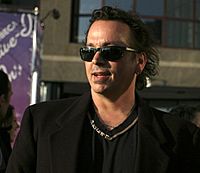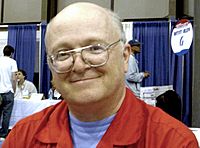Teenage Mutant Ninja Turtles facts for kids
Quick facts for kids Teenage Mutant Ninja Turtles |
|
|---|---|

Franchise logo
|
|
| Creator | |
| Original work | Teenage Mutant Ninja Turtles (1984) |
| Owner | Mirage Studios (1984–2009) Nickelodeon (Paramount) (2009–present) |
| Print publications | |
| Comics |
|
| Comic strips | Teenage Mutant Ninja Turtles (comic strip) (1990–1997) |
| Films and television | |
| Films | List of films |
| Games | |
| Role-playing | Teenage Mutant Ninja Turtles & Other Strangeness |
| Miscellaneous | |
| Toys | Teenage Mutant Ninja Turtles action figures |
| Characters | List of characters |
The Teenage Mutant Ninja Turtles (often called TMNT) is a popular American story series. It was created by comic artists Kevin Eastman and Peter Laird. The story is about four turtle brothers: Leonardo, Michelangelo, Donatello, and Raphael. They are special because they look like humans and are trained in ninjutsu, a Japanese martial art. These turtles fight bad guys in New York City.
The turtles are named after famous Italian Renaissance artists. Their team includes their wise rat teacher, Splinter. They also have human friends, April O'Neil and Casey Jones. Their main enemies are Shredder, Krang, and Baxter Stockman.
The TMNT story began as a comic book in 1984. It was a big surprise success. Later, the turtles became even more famous with toys and a cartoon show. Between 1988 and 1992, over $1.1 billion worth of Turtles toys were sold. This made them one of the best-selling toy lines ever at that time.
The first animated TV series started in 1987 and ran for almost ten years. In some parts of Europe, the name was changed to Teenage Mutant Hero Turtles. This was because "ninja" sounded too violent. Three live-action movies were also made. The first movie in 1990 earned a lot of money. Many video games have been released too. In 2009, the company Nickelodeon bought the TMNT franchise. Since then, new comics, movies, and TV shows have been made.
Contents
The Story Begins
How the Turtles Were Created
The comic book creators Kevin Eastman and Peter Laird first met in Massachusetts. They started working on drawings together. In 1983, Eastman drew a masked turtle standing on two legs, holding nunchucks. Laird then added the words "teenage mutant."
They thought of this idea as a funny take on popular superhero comics. These comics often had teenage heroes, mutants, and ninjas. They also liked the idea of funny animal characters.
Eastman and Laird decided to make a comic book. They chose to name the turtles after famous Italian Renaissance artists. These names were Leonardo, Raphael, Donatello, and Michelangelo. Laird said these names felt "quirky enough" for the idea.
They also created a background story for the turtles. It included a radioactive material that changed them. Their teacher, Splinter, was also part of this origin.
In March 1984, Eastman and Laird started their own comic book company called Mirage Studios. They used money from a tax refund and a loan to print their first comic. They advertised it in a magazine, and all 3,000 copies sold very quickly. More issues were printed, and sales kept growing.
Toys, Cartoons, and Games
The Turtles became very popular, especially with toys. About $1.1 billion worth of Turtles toys were sold in just four years. This made them the third best-selling toy figures at the time.
A cartoon show was made to help sell the toys. It started in 1987. This cartoon introduced many famous Turtles things. These included their different colored masks, their catchphrases, their love for pizza, and their unique personalities. The cartoon was made lighter and less violent than the comics. This made it suitable for kids and TV networks.
The first Turtles video game came out in 1989 for the Nintendo Entertainment System (NES). It was made by the Japanese company Konami. This game sold about four million copies, making it one of the best-selling NES games.
Movies and More Growth
The early 1990s were a very popular time for the TMNT franchise. The first Turtles movie was released in 1990. It used amazing costumes made by Jim Henson's Creature Shop. This movie was darker, more like the original comic. It was one of the highest-earning films of 1990. It made over $200 million worldwide.
A second movie, The Secret of the Ooze, came out the next year. A third movie, Teenage Mutant Ninja Turtles III, was released in 1993.
In 1990, a musical show called Coming Out of Their Shells toured the United States. The Turtles performed as a rock band. After the first cartoon ended, a live-action TV show called Ninja Turtles: The Next Mutation was made in 1997. It introduced a new female turtle named Venus de Milo. This show only lasted one season.
New Owners and New Adventures
In 2000, Kevin Eastman sold his part of the Turtles franchise to Peter Laird. In 2003, a new animated Turtles series started. It ran for seven seasons and ended with a TV movie in 2009. This series was closer to the original comics. A computer-animated Turtles movie called TMNT was released in 2007.
On October 21, 2009, Peter Laird sold the franchise to Viacom, which is now Paramount Global. Laird said he was tired of working on Turtles all the time. After this, a new Turtles comic series started in 2011. Kevin Eastman helped write and draw it.
A third animated series began in 2012 on Nickelodeon. It ran for five seasons. A fourth live-action Turtles movie came out in 2014. It was a big success at the box office. A sequel, Out of the Shadows, was released in 2016.
A fourth animated series, Rise of the Teenage Mutant Ninja Turtles, started in 2018. A movie based on this series was released on Netflix in 2022. More movies are planned for the future.
Meet the Characters
In most TMNT stories, the four baby turtles become human-like after touching radioactive ooze. They live in the sewers of New York City and fight bad guys.
- Leonardo is the leader of the group. He is very disciplined and skilled. He uses two katana swords and wears a blue bandana.
- Raphael is the strongest and most daring turtle. He can be a bit hot-headed. He wears a red bandana and uses two sai weapons.
- Donatello is the smart one. He invents cool gadgets and vehicles. He wears a purple mask and uses a bo staff.
- Michelangelo is the most fun-loving turtle. He is usually the fastest and most agile. He wears an orange bandana and uses nunchucks.
Splinter is a mutant rat. He is the wise adoptive father of the Turtles and teaches them ninjitsu. Sometimes, he was a pet rat who mutated. Other times, he was a human ninja master named Hamato Yoshi who turned into a rat.
The Turtles get help from April O'Neil. She is shown as a news reporter, a lab assistant, or a computer genius. She is often liked by Casey Jones. Casey wears a hockey mask and fights crime as a vigilante. He usually becomes a friend to the Turtles.
The Turtles' main enemy is Shredder. He leads a criminal ninja group called the Foot. His real name is usually Oroku Saki. Shredder often works with Karai, a skilled fighter. Sometimes she is his daughter. He also teams up with Baxter Stockman, a mad scientist, and Krang, an alien warlord.
Other bad guys include Bebop and Rocksteady. They are Shredder's silly henchmen, a mutant rhinoceros and a warthog.
Comics
The First Comics: Mirage Studios
Eastman and Laird's first Teenage Mutant Ninja Turtles comic came out in May 1984. It was published by their company, Mirage Studios. The first print run was only 3,000 copies. It was meant to be a single story, but it became so popular that it turned into a long-running series.
The main Mirage series had 129 issues in total. Many other special comics and mini-series were also published.
Comics for Younger Readers: Archie Comics
From 1988 to 1995, Archie Comics published Teenage Mutant Ninja Turtles Adventures. This series was made for younger readers. It first adapted stories from the 1987 cartoon. Later, it created its own new adventures.
New Stories: IDW Publishing
In 2011, IDW Publishing got the rights to make new Turtles comics. The first issue of their new series came out on August 24, 2011. Kevin Eastman, one of the original creators, helped write and draw this series. In 2017, issue No. 73 was published, making it the longest-running TMNT comic series ever. IDW also published comics based on the 2012 and 2018 animated TV shows.
Japanese Comics (Manga)
The Turtles have also appeared in several Japanese comic series, called manga. These include:
- Mutant Turtles (15 issues)
- Super Turtles (3 issues)
- Mutant Turtles Gaiden
- Mutant Turtles III (based on the third movie)
- Mutant Turtles '95 and Mutant Turtles '96
Newspaper Comic Strip
A daily Teenage Mutant Ninja Turtles comic strip started in newspapers in 1990. It had adventure stories during the week and puzzles on weekends. It was published in over 250 newspapers at its most popular time. The comic strip ended in December 1996.
Television Series
The First Cartoon (1987–1996)
The first animated series began in 1987. It showed the adventures of the Turtles and their friends fighting Shredder, Krang, and other bad guys in New York City. This show changed the Turtles' story to be more kid-friendly than the comics. It ran for ten seasons and ended in 1996.
Japanese Animated Series (1996)
In Japan, a special two-episode animated series was made in 1996. It was called Mutant Turtles: Choujin Densetsu-hen. This show was similar to the 1987 TV series. It showed the Turtles as superheroes who got special powers from "Mutastones."
Live-Action TV Show (1997–1998)
A live-action TV show, Ninja Turtles: The Next Mutation, aired from 1997 to 1998. It introduced a female turtle named Venus de Milo. She was skilled in mystical arts. The show was canceled after one season.
The Second Cartoon (2003–2009)
A new TMNT cartoon series started in 2003. This series was closer to the original comics. It had a slightly darker and more serious tone than the 1987 cartoon, but it was still good for younger viewers. This series lasted until 2009. It ended with a TV movie called Turtles Forever.
The Third Cartoon (2012–2017)
Nickelodeon bought the rights to Teenage Mutant Ninja Turtles in 2009. They announced a new computer-animated TMNT TV series. This 2012 version used anime-like art. It focused on how the mutagen (the ooze that changed them) kept affecting the Turtles and their enemies. The show ran for five seasons and ended in 2017.
The Fourth Cartoon (2018–2020)
Rise of the Teenage Mutant Ninja Turtles was the second cartoon made by Nickelodeon. It started in September 2018. This show went back to using 2D animation and had a lighter, more humorous style. It aired from 2018 to 2020. A movie based on this series was released on Netflix in 2022.
Films
| Film | U.S. release date | Director(s) | Screenwriter(s) | Story by | Producer(s) | |
|---|---|---|---|---|---|---|
| Original series | ||||||
| Teenage Mutant Ninja Turtles | March 30, 1990 | Steve Barron | Todd W. Langen and Bobby Herbeck | Bobby Herbeck | Kim Dawson, Simon Fields and David Chan | |
| Teenage Mutant Ninja Turtles II: The Secret of the Ooze | March 22, 1991 | Michael Pressman | Todd W. Langen | Thomas K. Gray, Kim Dawson and David Chan | ||
| Teenage Mutant Ninja Turtles III | March 19, 1993 | Stuart Gillard | ||||
| Reboot series | ||||||
| Teenage Mutant Ninja Turtles | August 8, 2014 | Jonathan Liebesman | Josh Appelbaum & André Nemec and Evan Daugherty | Michael Bay, Andrew Form, Brad Fuller, Galen Walker, Scott Mednick and Ian Bryce | ||
| Teenage Mutant Ninja Turtles: Out of the Shadows | June 3, 2016 | Dave Green | Josh Appelbaum & André Nemec | Michael Bay, Andrew Form, Brad Fuller, Galen Walker and Scott Mednick | ||
| Animated films | ||||||
| TMNT | March 23, 2007 | Kevin Munroe | Thomas K. Gray, Galen Walker and Paul Wang | |||
| Teenage Mutant Ninja Turtles: Mutant Mayhem | August 4, 2023 | Jeff Rowe | Brendan O'Brien | Seth Rogen, Evan Goldberg and James Weaver | ||
The Turtles have been in six movies shown in theaters. The first three were live-action films made in the early 1990s: Teenage Mutant Ninja Turtles (1990), Teenage Mutant Ninja Turtles II: The Secret of the Ooze (1991), and Teenage Mutant Ninja Turtles III (1993). In these movies, actors wore costumes with special moving heads. The fourth movie, TMNT, was a computer-animated film released in 2007.
A new live-action movie, also called Teenage Mutant Ninja Turtles, came out in 2014. A sequel, Teenage Mutant Ninja Turtles: Out of the Shadows, was released in 2016. A new computer-animated movie called Teenage Mutant Ninja Turtles: Mutant Mayhem is set to be released in 2023.
Merchandise
Toys
The TMNT franchise has sold a lot of merchandise. By 1994, it had made over $6 billion in sales from toys and other products. Artists from Mirage Studios helped design many of the action figures, vehicles, and playsets.
The TMNT action figures were very popular for over twenty years. They made billions of dollars in sales. In the UK, one store even dedicated its entire basement to Turtles items during Christmas.
Video Games
Many TMNT video games have been made, mostly by Konami. The first game for a home console, Teenage Mutant Ninja Turtles, came out for the Nintendo Entertainment System (NES) in 1989. An arcade game, also called Teenage Mutant Ninja Turtles, was released in 1989. It was later made into a game for the NES.
Other popular Konami games included Teenage Mutant Ninja Turtles: Turtles in Time (1991) for arcades and Super NES, and Teenage Mutant Ninja Turtles: The Hyperstone Heist for Sega Genesis. There were also three TMNT games for the original Game Boy.
Konami also made a series of 3D games based on the 2003 TV series. These included Teenage Mutant Ninja Turtles (2003 video game), Teenage Mutant Ninja Turtles 2: Battle Nexus, and Teenage Mutant Ninja Turtles 3: Mutant Nightmare.
Later, Ubisoft and Activision made TMNT games. In 2016, Activision and PlatinumGames made Teenage Mutant Ninja Turtles: Mutants in Manhattan. It was a team-based fighting game.
The Turtles also appear in other fighting games. Leonardo, Michelangelo, April O'Neil, and Shredder are playable characters in Nickelodeon All-Star Brawl. All four Turtles are also in the fighting game Brawlhalla.
Teenage Mutant Ninja Turtles: Shredder's Revenge, a fighting game where you beat up enemies, was released in June 2022. It features all four Turtles, April, Splinter, and Casey Jones as playable characters.
Other Fun Stuff
Concert Tour
To celebrate the Turtles' popularity, a concert tour called "Coming Out of Their Shells" was held in 1990. The Turtles performed as a rock band on stage. Donatello played keyboards, Leonardo played bass guitar, Raphael played drums and saxophone, and Michelangelo played guitar. The story of the show was about the Turtles saving April O'Neil from Shredder. The tour was sponsored by Pizza Hut.
Roller Coasters and Rides
There are several TMNT-themed rides at Nickelodeon Universe parks.
- At American Dream Meadowlands in New Jersey, the TMNT Shellraiser is one of the steepest roller coasters in the world. The Shredder is a spinning roller coaster that is the world's longest free-spinning coaster.
- At Mall of America in Minnesota, there are rides like Teenage Mutant Ninja Turtles Shell Shock and Shredder's Mutant Masher.
Images for kids
See also
 In Spanish: Tortugas Ninja para niños
In Spanish: Tortugas Ninja para niños






